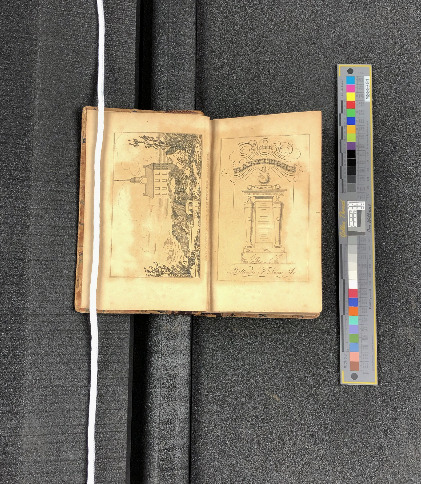Social & Family History Merge in Latrobe's Digitized 'Picture of Baltimore'
- AnnShafer
- Nov 13, 2020
- 4 min read
Updated: Feb 3, 2021
by Ann Shafer
In 1832, Baltimore’s Fielding Lucas published John Hazelhurst Boneval Latrobe’s Picture of Baltimore: Containing a Description of All Objects of Interest in the City; and Embellished with Views of the Principal Public Buildings. This diminutive volume (it measures 5 1/2 x 3 1/2 x 1 1/8 inches) was meant to act as a tour book of the city and included some ninety of Latrobe’s renderings of important buildings along with a fold-out map tipped in at the back. Latrobe (1803–1891) wrote in the introduction that a description of towns like Baltimore “enable the stranger to pass from object to object of interest, gratify his curiosity, furnish him with amusement, give him valuable information, and, if he is a man of business, facilitate the objects of his visit….” The introduction concluded with an entreaty to users of the book to report any mistakes to the publisher. Picture of Baltimore is approximately the size of an iPhone, but with 240 pages its bulk might have been a tight fit in the pocket of a gentleman’s coat. It is possible, too, to imagine well-dressed ladies navigating the sights from their carriage. With descriptions of each building—like the Penitentiary—including their function, the book is a remarkable record of 1830s Baltimore, then the third largest city in America.
While history buffs would certainly be pleased to come across such a book in an antiquarian bookseller’s shop, when Ferdinand C. Latrobe IV found Picture of Baltimore at Kelmscott, a Baltimore bookseller, he and his cousin Jack Heyrman were thrilled because they both are Latrobe’s great, great grandsons. Not only was author John H.B. Latrobe an accomplished artist (among many other things), several of the buildings included in the book were designed by his father, the federalist architect Benjamin Henry Latrobe (1764–1820), including the Baltimore Basilica. Heyrman agreed with his cousin that the book was rare and immediately determined to acquire it, preserve it, and make it accessible to future generations via digitization.

The decision to digitize the book was easy. In fact, it was Heyrman’s grandmother that convinced him. She was the caretaker of the family papers for many years and worked diligently to protect the legacy of her husband’s storied family after he died suddenly in his fifties. For many years she kept the voluminous papers of Benjamin Latrobe in a trunk in her apartment until 1975 when he remembers she was pleased to place them with the Maryland Historical Society (now known as the Maryland Center for History and Culture). The papers have since been published by Yale University and comprise ten large volumes (journals [3 volumes], correspondence [3], watercolors [1], architectural [2] and engineering [1] drawings), which are invaluable to scholars of early nineteenth century America. Thinking about how easily the trunk of papers could have been destroyed by fire prompted Heyrman to take his cousin’s advice and engage Full Circle’s digitization services. “More people should digitize books like this, or family Bibles and the like,” said Heyrman. “Otherwise they will eventually be lost. It’s important to do it for the next generation, the one after that, and the one after that.”
Old books, particularly of a small size, are challenging to photograph. Their bindings are often so tight that opening them fully is close to impossible. They require great care, state-of-the-art equipment, and lots of patience. They certainly cannot be placed flat down on a scanner, rather, they must be carefully set up on a book cradle, enabling the binding to remain stable, while the camera or cameras need to be adjusted accordingly. Digital Imaging Specialist at Full Circle, James Singewald, took on this important task and was perfect for the job since he had worked for many years at the Maryland Historical Society digitizing its extensive holdings. He eagerly set about photographing the pages of the Latrobe volume and later reported: “Shooting a book that is so integral to local history and shows buildings that are still standing was amazing. The Maryland Historical Society has the papers of Benjamin Latrobe, much of which I photographed, and to see his son’s take on the city’s architecture was awesome. I also had the chance to meet several Latrobe descendants recently, which made me feel even more connected to the history of Baltimore.”

As the future unfolds, preserving our history is imperative and through digitization, its images and even stories can be reinterpreted and shared with a vast audience. The team at Full Circle Archive Digitization understands the intrinsic value and delicacy of original materials. Not only does the team welcome single objects from private collections such as this rediscovered heirloom, but also it specializes in comprehensive archive digitization projects delivering unparalleled quality to museums, libraries, archives, and corporate collections. With careful planning, Heyrman’s book by his great- great grandfather can be enjoyed without jeopardizing the original object and its stories can be told of a city in its heyday.
Full Circle Archive Digitization helps individuals and institutions digitize precious and delicate materials. Our method includes in-depth consultation, meticulous planning and preparation, and high-resolution rapid capture. We safely archive photograph and film collections, glass plates, fine art prints and paintings, books, blueprints, and other artifacts. We are invested in preserving history for future generations and welcome projects large and small. We are proud to be making the future of historical-information dissemination and storytelling a reality.




















I've read your article. Honestly, I've never read this type of informative and efficient article before. This article will help lots of beginners like me to build skills in embroidery. Love to read your incoming blogs too. Really appreciate your work and dedication.
We have custom digitized embroidery designs to fulfill your embroidery needs.